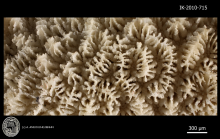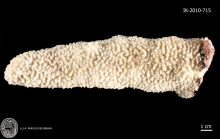
| Intro | | About | | Wiki | | Search traits | | Data explorer | | Literature | | Definitions | | Sources | | Webservices | | Statistics | | Feedback | | Editors | | Log in |
WoRMS name detailsScapophyllia Milne Edwards & Haime, 1848
267828 (urn:lsid:marinespecies.org:taxname:267828)
unaccepted > junior subjective synonym
Genus
Scapophyllia cylindrica Milne Edwards & Haime, 1849 accepted as Merulina cylindrica (Milne Edwards & Haime, 1849) (type by subsequent designation)
marine,
Milne Edwards, H.; Haime, J. (1848). Note sur la classification de la deuxième tribu de la famille des Astréides. <em>Comptes rendus hebdomadaires des séances de l'Académie des sciences, Paris.</em> 27: 490–497., available online at https://doi.org/10.5962/bhl.part.29692 [details]
Description 'Polypier cylindrique, dressé et composé de séries intimement unies par les murailles. Columelle tuberculeuse. Cloisons...
Description 'Polypier cylindrique, dressé et composé de séries intimement unies par les murailles. Columelle tuberculeuse. Cloisons extrêmement épaisses et fortement granulées.' (Milne Edwards and Haime, 1848, vol. 27: 492) [details] Nomenclature The type species has been moved to Merulina by Rowlett (2020). Therefore Scapophyllia has become a junior synonym of Merulina.
Nomenclature The type species has been moved to Merulina by Rowlett (2020). Therefore Scapophyllia has become a junior synonym of Merulina. [details]
Hoeksema, B. W.; Cairns, S. (2025). World List of Scleractinia. Scapophyllia Milne Edwards & Haime, 1848. Accessed through: World Register of Marine Species at: https://marinespecies.org/aphia.php?p=taxdetails&id=267828 on 2025-05-06
Date action by
Nomenclatureoriginal description
Milne Edwards, H.; Haime, J. (1848). Note sur la classification de la deuxième tribu de la famille des Astréides. <em>Comptes rendus hebdomadaires des séances de l'Académie des sciences, Paris.</em> 27: 490–497., available online at https://doi.org/10.5962/bhl.part.29692 [details] basis of record van der Land, J. (ed). (2008). UNESCO-IOC Register of Marine Organisms (URMO). , available online at http://www.marinespecies.org/urmo/ [details] Taxonomysource of synonymy
Rowlett J. (2020). Indo-Pacific Corals. <em>Rowlett (self-published).</em> pp. 1-809. [details] Othercontext source (Hexacorallia)
Fautin, Daphne G. (2013). Hexacorallians of the World. (look up in IMIS) [details]
additional source Veron JEN, Pichon M. (1980). Scleractinia of Eastern Australia – Part III. Family Agariciidae, Siderastreidae, Fungiidae, Oculinidae, Merulinidae, Mussidae, Pectinidae, Caryophyllidae, Dendrophylliidae. <em>Australian Institute of Marine Science Monograph Series.</em> 4: 1-459. [details] additional source Veron JEN. (2000). Corals of the World. Vol. 1–3. <em>Australian Institute of Marine Science and CRR, Queensland, Australia.</em> [details] additional source Budd AF, Fukami H, Smith ND, Knowlton N. (2012). Taxonomic classification of the reef coral family Mussidae (Cnidaria: Anthozoa: Scleractinia). <em>Zoological Journal of the Linnean Society.</em> 166 (3): 465-529., available online at https://doi.org/10.1111/j.1096-3642.2012.00855.x [details] additional source Matthai G. (1928). A Monograph of the Recent meandroid Astraeidae. <em>Catalogue of the Madreporarian Corals in the British Museum (Natural History).</em> 7: 1-288, pls. 1-72. [details] Available for editors additional source Huang D, Benzoni F, Fukami H, Knowlton N, Smith ND, Budd AF (2014) Taxonomic classification of the reef coral families Merulinidae, Montastraeidae, and Diploastraeidae (Cnidaria: Anthozoa: Scleractinia). Zoological Journal of the Linnean Society 171: 277–355., available online at https://doi.org/10.1111/zoj.12140 [details] additional source Duncan PM (1884) A revision of the families and genera of the sclerodermic Zoantharia, Ed. & H., or Madreporaria (M. Rugosa excepted). Journal of the Linnean Society of London, 18: 1-204. [details] additional source Dunn, D. F. (1982). Cnidaria. McGraw-Hill Book Company. New York and other cities., volume 1, pp. 669-706 page(s): 702 [details]  Present Present  Inaccurate Inaccurate  Introduced: alien Introduced: alien  Containing type locality Containing type locality
From editor or global species database
Comparison No apomorphies have been uncovered for Scapophyllia as yet. It shares all but one morphological character with Merulina, and they are distinguishable based on septal count—Scapophyllia with the plesiomorphy of 3 cycles (24–36 septa), and less for Merulina. Loss of epitheca and sparse endotheca occur at the base of the Merulina + Scapophyllia clade, setting Goniastrea apart from them. All subcorallite characters are shared with most of Goniastrea. [details]Description 'Polypier cylindrique, dressé et composé de séries intimement unies par les murailles. Columelle tuberculeuse. Cloisons extrêmement épaisses et fortement granulées.' (Milne Edwards and Haime, 1848, vol. 27: 492) [details] Diagnosis Colonial, with intracalicular budding only. Corallites monomorphic and uniserial; monticules absent. Walls fused. Calice width small (4 mm), with low relief (3 mm). Costosepta confluent. Septa in 3 cycles (24–36 septa). Free septa present but irregular. Septa spaced 6–11 septa per 5 mm. Costosepta equal in relative thickness. Columellae trabecular but compact (1–3 threads), 1/4 of calice width, and continuous among adjacent corallites. Paliform (uniaxial) lobes well developed. Epitheca absent and endothelia sparse. Tooth base at mid-calice circular. Tooth tip at mid-calice irregular; tip orientation perpendicular to septum. Tooth height low (< 0.3 mm) and tooth spacing narrow (< 0.3 mm), with > 6 teeth per septum. Granules scattered on septal face; irregular in shape. Interarea palisade. Walls formed by strong abortive septa and partial septotheca; trabeculothecal elements may be present. Thickening deposits fibrous. Costa center clusters weak; < 0.3 mm between clusters; medial lines weak. Septum center clusters weak; < 0.3 mm between clusters; medial lines weak. Transverse crosses absent. Columella centers clustered. [details] Nomenclature The type species has been moved to Merulina by Rowlett (2020). Therefore Scapophyllia has become a junior synonym of Merulina. [details] Remark Scapophyllia Milne Edwards and Haime, 1848, vol. 27: 492 is a monotypic genus that is often regarded as a close relative of Merulina. Their taxonomic histories have overlapped substantially, being placed together in Merulinidae for the most part (e.g. Vaughan and Wells, 1943: 190; Wells, 1956: F416; Veron, 2000, vol. 2: 363). It has been described as another genus only once, not surprisingly as a Merulina—M. studeri Bedot, 1907: 214, pl. 31: figs 156, 160. Molecular phylogenies demonstrate this affiliation, with these two genera forming a well-supported clade (subclade A) along with some Goniastrea spp. (Fukami et al., 2008; Huang et al., 2011). [details] |

